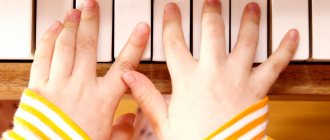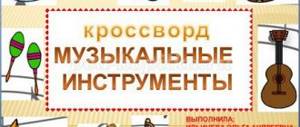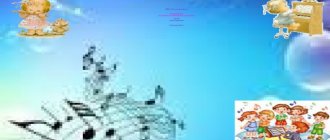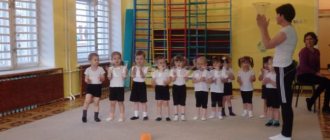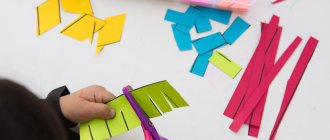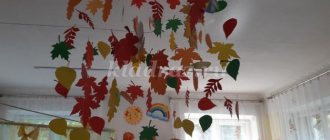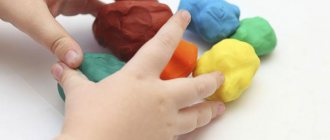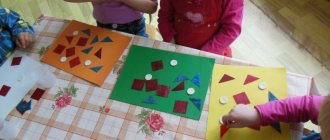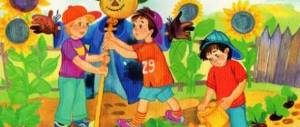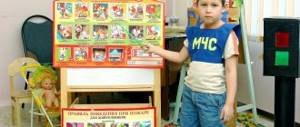Labor activity file
Labor activity in the younger group is aimed at consolidating the everyday aspects of a healthy person’s life. The children in the second junior group cannot yet be called independent; many of them already know how to perform some everyday tasks without outside help: take off their shoes, take off their hats, put their clothes in a locker. But there are children who cannot cope with such tasks on their own. In order to help them learn to perform some feasible actions alone, as well as to assist a friend in some simple matters, educators conduct games that develop work activity.
Kids are playing
For each school year, teachers draw up notes with a plan of tasks that a child at his age is able to complete. For younger groups, these could be the following activities:
- for girls - playing mother-daughter with a doll that is dirty and needs a bath;
- for boys - a game of car wash, where construction vehicles enter;
- for everyone - wet cleaning of the play rack in order to expel the mud bug from the group, which spoils the toys;
- for everyone - in the summer, after a walk, washing not only your hands, but also your feet, so as not to introduce dangerous bacteria into the bed and into the group.
Washing toys
Approximate list of work assignments
Tasks that are feasible for children of the second junior group and should already be fully mastered:
- hand washing;
- removing used dishes to a specially designated place;
- putting toys back in their places after playing;
- straightening wardrobe items for changing clothes (the skill of turning out pants or tights, identifying the front and back sides, the front and back of clothes);
- teeth cleaning;
- putting the bed in order after sleep (make up).
General instructions
Household labor, used in the second junior group, in most cases is of a collective nature. All together the guys do several useful things, joining the world of adults. At the same time as playing, children learn to clean up dishes after themselves, be careful with wardrobe items, and take care of indoor plants. As a result of successfully teaching a conscious attitude towards their property, which should only be put away in their own locker, children no longer scatter their clothes after a walk, but fold them neatly.
Cleaning dishes
Raising respect for order in children creates the habit of thinking rationally and creating a sequence of actions to achieve the best result. After each meal in the dining room, the children all clean up the dishes together, taking them to a specially designated table.
Means of labor education for children
Interesting! Boys are quicker than girls to understand that if small objects (spoons and forks) are placed on a plate, they will have to go to the table and back fewer times. Girls will try to simplify their work by just watching the boys.
Individual orders
The goal of individual work is to independently implement the assigned task without the opportunity to spy on a friend or do something together. The favorite activity of girls, caring for indoor plants, is not of interest to most boys, but tasks cannot be divided by gender, because boys must also learn care and respect.
Planning of work activities
It is difficult to make children understand the importance of this or that everyday action the first time if you just talk about it.
Interesting! Labor must be played. Children's interest in play helps to learn the importance of daily activities and instill responsibility for their implementation.
Playing the “Mashu-Zamorasha doll” firmly reinforces the obligation to perform hygienic procedures - wash your hands before eating, brush your teeth after eating, wash before going to bed. The teacher brings a dirty doll into the group and asks to tell Masha why it is so important to keep the body clean.
During walks in winter, children are taught to take care of birds that remain for the winter. For this purpose, they distribute food that children feed to pigeons and sparrows. In addition to caring about nature, the teacher talks about how snow, although cold, warms the rhizomes of trees during severe frosts and strong winds. Pupils are offered to move snow from paths and benches under the trees growing on the territory of the kindergarten. Thanks to such work and care, benches and sidewalks become cleaner, and trees endure winter more easily.
Winter labor
Musical lesson in kindergarten in the second junior group. Abstract
Summary of an open music lesson in the junior group “Bunny visiting the children”
Goal : Development of the emotional sphere of preschoolers using various types of musical activities. Objectives: • teach children to hear the expressiveness of music; • introduce new musical instruments and their methods of producing sounds; consolidation of knowledge about already studied musical instruments; • learn to react to changes in the character of a musical work; • development of communication abilities Attributes for musical activities: • Musical instruments (rattles) • Soft toy hare
Lesson progress:
Children enter the hall Musical director : Hello, guys! (singing) Children : Hello! Musical director: (listens) Listen, children, it seems like someone is knocking on our door. (brings out a bunny toy). Once upon a time there was a bunny with long ears. The bunny's nose froze at the edge of the forest. My nose froze, my tail froze, and I went to visit the kids to warm up. It's warm and nice there, there's no wolf, and they give you carrots for lunch! Guys, the bunny is shaking all over, he is very cold. Let's warm the bunny and warm ourselves. 1. Musical and rhythmic movements “Winter Dance” by Mus. Starokadomsky, spinning in place, spring After warming up, the children walk and sit down. 2. Listening to music Music director : Guys, the bunny felt warm, and from the long journey to our kindergarten he was very tired and wanted to sleep. When the bunny wants to sleep, the bunny's mother sings him a gentle, affectionate lullaby, strokes his long ears, the bunny falls asleep and dreams of a sweet carrot. (I turn on the “Lullaby of the Bunny” music. And Filippenko suggests that the children take a nap with the Bunny) 3. Singing Musical director: Bunny, why are you so sad (The Bunny whispers in the music director’s ear that he is sad because he dreamed about his mother, Bunny is very I miss my mom). Bunny, don’t be sad, our children are learning a very funny song about their mother, would you like to learn this song with us? Song “We love mommy very much” 4. Playing children's musical instruments Musical director: Guys, the bunny brought a package. Let's see what's there? (Children answer) What is this? The bunny doesn't know. The bunny is a rattle. We are silent while we lie, If you shake us, we will make a sound. I distribute tools to children. Children play music to r.n.m. “Lady” The bunny is dancing in the hands of the teacher Musical director : Bunny, he was dancing and a little tired, you little bunny, take a rest, look at the kids. And the kids will now dance for the bunny 5. Dance “Entertainment” Muses. L. Nekrasova Musical director : Guys, sit on the chairs, the autumn bunny wants to play with you 6. Game “Where are our hands?” muz.Lomovoy Musical director: Guys, the bunny says that it’s time for him to return to the forest to his mother, he will tell his mother that he met good kids who taught him to sing and play musical instruments, rattles, dance and play. (the bunny says goodbye to the guys) The children leave the hall in a flock to the sound of music.
We recommend watching:
Children's opera-game "Cockerel" for the second group of early age (from 1 to 2 years old) Summary of a music lesson in the 1st junior group Musical entertainment for the younger group. Toy store Summary of a music lesson in a junior group on the topic: Spring
Similar articles:
Thematic lesson on the theme “Bunny” for children of primary preschool age
Analysis of work activity in the junior group
To assess a child's ability to care, not to be lazy and to work, a game is played, participation in which takes a long time. The most common game among educators is the game “Our Garden.”
Pupils are encouraged to plant certain seeds and care for them until they sprout. The resulting seedlings, together with the teacher, are planted on the territory of the preschool educational institution or in pots in a group.
Labor activity in the preparatory group
Interesting! Prospective analysis makes it possible not only to identify children who are incapable of caring for children, but also to clearly tell children about how some common fruits, vegetables, and herbs are grown.
Diagnosis of diligence control
Throughout the year, from time to time, during walks or in a group, children are offered work of a different nature, within their capabilities. The teacher, in a playful way, asks the children to wipe dust from the foliage of indoor plants, encouraging them with praise about how big boys and girls have grown and can do everything, but their mutual friend Dunno does not know how to water flowers or wipe dust. All the action takes place in front of the teacher, but after several training sessions the children themselves must pour water into watering cans, wet rags and take care of the flowers.
Attention! While the pupils are fascinated by the process, the teacher fills out a diagnostic card for the group, in which he makes notes on how quickly everyone figured out where to get water, how to identify plants that needed watering, and which of the preschoolers helped a friend and who accepted this help.
Plant care
Objectives of musical education second junior group
TASKS OF MUSICAL EDUCATION
Second junior group
(three to four years)
* Cultivate emotional responsiveness to music.
* Introduce three musical genres: song, dance, march.
* Promote the development of musical memory, form skills
recognize familiar songs and plays; feel the character of the music (cheerful,
cheerful, calm), react to it emotionally.
Hearing
Teach children to listen to a piece of music to the end, understand the nature of the music, and tell what the song is about. Develop the ability to distinguish sounds by pitch within an octave, to notice changes in the strength of the sound of a melody (loud, quiet). Improve the ability to distinguish the sound of musical toys and children's musical instruments (rattle, drum, tambourine, metallophone).
Singing
Promote the development of singing skills: sing without tension in the range of fifths; at the same tempo with everyone, clearly pronounce the words, convey the character of the song (fun, drawn-out, affectionate).
Musical and rhythmic movements
Improve basic movement skills (walking, running). Learn to respond to the beginning and end of music. Improve the quality of dance movements: stomp alternately with two feet and one foot. Develop the ability to circle in pairs, perform a straight gallop, move rhythmically to the music and according to the tempo and character of the musical piece, with or without objects, toys.
To promote the development of skills in expressive and emotional transmission of playful and fairy-tale images: a bear is walking, little mice are running, a bunny is jumping, cars are driving, etc.
Develop spatial orientation skills.
Playing children's musical instruments
Introduce children to some children's musical instruments: pipe, metallophone, bell, tambourine, rattle, drum, as well as their sound. To promote the acquisition of basic skills in playing along with children's percussion musical instruments.
By the end of the year, children can
- Listen to a piece of music to the end, recognize familiar songs,
distinguish sounds by height (within an octave).
- Notice changes in sound (quiet - loud).
- Sing without falling behind or ahead of each other.
- Perform dance movements: spin in pairs, stomp
alternate feet, move to music with objects (flags,
handkerchiefs, leaves, etc.)
- Identify and name children's musical instruments (metallophone,
drum, bell, etc.)
TASKS OF MUSICAL EDUCATION
Middle group
(four to five years)
* Continue to develop children's interest in music, the desire to listen to it, and evoke emotional responsiveness when perceiving musical works.
* Enrich musical experiences, contribute to the further development of the foundations of musical culture.
Hearing
To develop the skills of a culture of listening to music (not to be distracted and not to distract others, to listen to the piece to the end). Learn to feel the character of music, recognize familiar melodies, and express your impressions.
Notice the dynamics of a musical work, its means of expression: quiet, loud, slow, fast. Develop the ability to distinguish sounds by pitch (high, low within a sixth, seventh).
Singing
To teach children expressive singing, to develop the ability to sing in a drawn-out, agile, consistent manner (within the D - Si of the first octave). Develop the ability to take breath between short musical phrases. Promote the desire to sing a melody clearly, soften the ends of phrases, pronounce words clearly, sing expressively, conveying the character of the music. Learn to sing with and without instrumental accompaniment (with the help of a teacher).
Musical and rhythmic movements
Continue to develop in children the skill of rhythmic movement in accordance with the nature of the music, independently change movements in accordance with the two- and three-part form of music. Improve dance movements: straight gallop, spring, circling alone and in pairs. Teach children the ability to move in pairs in a circle in dances and round dances, put their feet on toes and heels, clap their hands rhythmically, perform simple formations (from the circle scattered and back), and jumps. Continue to improve the skills of basic movements (walking: “solemn”, calm, “mysterious”; running: light and swift).
Development of dance and gaming creativity
To promote the development of emotional and imaginative performance of musical and playful exercises (leaves spinning, snowflakes falling) and skits using facial expressions and pantomime (happy and sad bunny, cunning fox, angry wolf, proud cockerel, etc.). Learn to dramatize songs, musical games and stage small musical performances.
Playing children's musical instruments
To develop the ability to play along with simple melodies on wooden spoons, rattles, drums, and metallophones.
By the end of the year, children can
- Listen carefully to a piece of music, feel it
character; express your feelings with words, drawings, movement.
- Recognize songs by melody.
- Distinguish sounds by pitch (within a sixth - seventh).
- Sing slowly, pronounce words clearly; start together and
finish singing.
- Perform movements that correspond to the nature of the music, independently changing them in accordance with the two-part form of the musical work.
- Perform dance movements: springing, jumping, moving in pairs in a circle, circling alone and in pairs.
- Perform movements with objects (dolls, toys, ribbons).
- Dramatize (together with the teacher) songs and round dances.
- Play the simplest melodies on one sound on a metallophone.
TASKS OF MUSICAL EDUCATION
Senior group
(five to six years)
Continue to develop aesthetic perception, interest, love for music, form a musical culture based on acquaintance with composers, classical, folk and modern music.
Continue to develop children’s musical abilities: pitch, rhythmic, timbre, dynamic hearing; emotional responsiveness and creative activity.
To promote the further development of singing skills, movements to music, playing and improvising melodies on children's musical instruments.
Hearing
Learn to distinguish between genres of musical works (march, dance, song). Improve musical memory through recognizing melodies from individual fragments of a work (introduction, conclusion, musical phrase). Improve the skill of distinguishing sounds in pitch within fifths, the sound of a musical instrument (keyboards, percussion and strings: piano, violin, cello, balalaika).
Singing
To develop singing skills, the ability to sing with a light sound in the range from “D” of the first octave to “C” of the second octave; take a breath before the start of a song, between musical phrases, pronounce words clearly, start and end a song in a timely manner, emotionally convey
give character to the melody, sing moderately, loudly and quietly. To promote the development of solo singing skills, with and without musical accompaniment. Promote the manifestation of independence and creative performance of songs of a different nature. Create a fund of favorite songs, thereby developing song and musical taste.
Song creativity
Learn to improvise a melody to a given text. To develop the ability to compose melodies of various types: a tender lullaby, a perky or cheerful march, a smooth waltz, a cheerful dance song.
Musical and rhythmic movements
Develop a sense of rhythm, the ability to convey through movements the character of music, its emotional and figurative content, freely navigate in space, perform simple changes, independently move from moderate to fast or slow tempo, change movements in accordance with musical phrases. To promote the formation of skills in performing dance movements (alternately throwing the legs forward in a jump; side step with a squat, moving forward, spinning; squatting with putting the leg forward). Form dance creativity.
Continue to develop song dramatization skills; learn to improvise images of fairy-tale animals and birds (horse, goat, fox, bear, hare, crane, raven, etc.) in different game situations. Introduce Russian round dance, dance, and dances of other nations.
Musical, gaming and dance creativity
Develop dance creativity; learn to come up with movements for dances, dances, compose a dance composition, showing originality and independence in creativity. Learn to improvise the movements of different characters to music of the appropriate nature; independently come up with movements that reflect the content of the song; come up with simple dance moves. Encourage them to dramatize the content of songs and round dances.
Playing children's musical instruments
Teach children to perform simple melodies on children's musical instruments; perform familiar songs individually and in small groups, while maintaining overall dynamics and tempo. Develop children's creativity, encourage them to take active independent action.
By the end of the year, children can
- Distinguish between genres of musical works (march, dance, song); sound of musical instruments (piano, violin); works based on melody and introduction.
- Distinguish between high and low sounds (within fifths).
- Sing without tension, smoothly, with a light sound; pronounce words clearly, start and end the song in a timely manner; sing accompanied by a musical instrument.
- Move rhythmically in accordance with the different character and dynamics of the music.
- Change movements independently in accordance with the three-part form of a piece of music and musical phrases.
- Perform dance movements: alternately throwing the legs forward in a jump, half-squatting with the foot on the heel, stepping on the entire foot in place, moving forward and in a circle.
- Independently dramatize the content of songs, round dances, act without imitating each other.
- Play melodies on the metallophone one at a time and in small groups.
TASKS OF MUSICAL EDUCATION
Preparatory group for school
(six to seven years old)
Continue to introduce children to musical culture. To cultivate artistic taste, a conscious attitude towards the national musical heritage and modern music. Improve
pitch, rhythmic, timbre and dynamic hearing. Continue to enrich children’s musical experiences and evoke a vivid emotional response when perceiving music of a different nature. To promote the further formation of the singing voice and the development of movement skills to music. Teach children to play musical instruments. Introduce basic musical concepts.
Hearing
Continue to develop the skills of perceiving sounds in pitch within the fifth - third; enrich children's impressions and form musical taste, develop musical memory. When analyzing musical works, learn to clearly express your feelings, thoughts, emotional perceptions and sensations. Promote the development of thinking, imagination, memory, hearing. Develop vocabulary to determine the nature of a piece of music. To introduce elementary musical concepts (register, dynamics, duration, tempo, rhythm; vocal, instrumental and orchestral music; performer; genres: ballet, opera, symphony, concert), the works of composers: J. S. Bach, W. A. Mozart , M. Glinka, N. Rimsky-Korsakov, P. Tchaikovsky, S. Prokofiev, D. Kabalevsky and others. Introduce children to the National Anthem of the Russian Federation.
Singing
Improve your singing voice and vocal-auditory coordination. To consolidate practical skills in the expressive performance of songs ranging from “C” of the first octave to “D” of the second octave; learn to take your breath and hold it until the end of the phrase; pay attention to articulation (diction). Strengthen the ability to sing independently, individually and collectively, with and without musical accompaniment.
Song creativity
Learn to come up with your own melodies, using Russian folk songs and dances as a model; independently improvise melodies on a given topic with or without a model, using familiar songs, plays and dances.
Musical and rhythmic movements
To promote the further development of dance movement skills, the ability to expressively convey emotional and figurative content in dance. To introduce the features of national dances (Russian, Belarusian, Ukrainian, etc.) and ballroom dancing. Develop dance and play creativity; to develop skills in the artistic performance of various images when staging songs, dances, and theatrical performances.
Musical, gaming and dance creativity
To promote the development of children's creative activity in accessible types of musical performing activities (playing in an orchestra, singing, dance movements, etc.). Teach children to improvise to music corresponding to the nature of the movements of people (skier, skater, rider, fisherman, etc.), images of animals (a crafty cat and an angry goat); characteristic movements of Russian dances. Learn to independently invent movements that reflect the content of the song, variations of elements of dance movements; act expressively with imaginary objects, independently look for a way to convey musical images in movements. Stimulate the formation of musical abilities, thinking, fantasy, imagination; promote the manifestation of activity and independence.
Playing children's musical instruments
Introduce musical works performed by various instruments and in orchestral arrangements. Learn to play the metallophone, pipe, percussion and electronic musical instruments, Russian folk musical instruments: rattles, rattles, triangles; perform musical works in an orchestra and ensemble.
By the end of the year, children can
- Find out the melody of the National Anthem of the Russian Federation.
- Determine to which genre the listened work belongs (march, song, dance) and on which of the famous instruments it is performed.
- Distinguish between parts of a work (introduction, conclusion, chorus, chorus).
- Listen carefully to the music, respond emotionally to the feelings and moods expressed in it.
- Determine the general mood, the nature of the musical work as a whole and its parts; highlight individual means of expression: tempo, dynamics, timbre; in some cases - the intonation melodic features of a musical piece.
- Hear visual moments in music that correspond to the title of the play, recognize characteristic images.
- Express your impressions of music in movements or drawings.
- Sing simple songs in a comfortable range, performing them expressively and musically, conveying the melody correctly (speeding up, slowing down, strengthening and weakening the sound).
- Reproduce and sing clearly the general direction of the melody and its individual segments with accompaniment.
- Maintain the correct position of the body when singing, articulating relatively freely, and correctly distributing breathing.
- Sing individually and collectively, with or without accompaniment.
- Move expressively and rhythmically in accordance with the varied nature of music and musical images; transmit non-
complex musical rhythmic pattern; start moving independently after the musical introduction; actively participate in creative tasks.
- Perform dance movements: step with stomp, side step with squat, spring step, side gallop, variable step; expressively and rhythmically perform dances and movements with objects (balls, hoops, balls, flowers).
- Dramatize game songs, come up with options for figurative movements in games and round dances.
- Perform simple songs and melodies solo and in an ensemble on percussion and high-pitched children's musical instruments.
Municipal preschool educational institution
Kindergarten No. 4 “Goldfish”
Consultation for parents
«Objectives of music education for the 2010/11 school year. year
according to program requirements
for each age group»
Musical director:
Mikhetkina Elena Vladimirovna
Vilyuchinsk
2010

